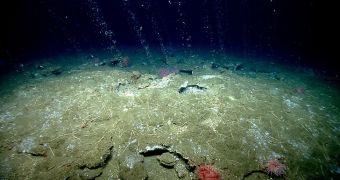Some might be tempted to think that, in this day and age, the natural world cannot possibly hold any more mysteries for the scientific community. As it turns out, this is not the case. On the contrary, there is a lot that we don't yet know about our planet.
Thus, a paper published in yesterday's issue of the journal Nature Geoscience announces the discovery of hundreds of previously undocumented gas plumes along the US Atlantic Coast.
These gas plumes, some of which are pictured next to this article, originate from the seafloor. Although this is yet to be confirmed, specialists suspect that the gas bubbles are chiefly made up of methane.
The gas plumes were documented with the help of sonar scans of the US Atlantic Coast. All in all, 570 such seeps have until now been pinned down between North Carolina's Cape Hatteras and Massachusetts' Georges Bank.
Researchers explain that the discovery of these gas plumes is all the more startling given the fact that, up until recently, this region of the Atlantic Coast was believed to accommodate for less than a dozen such seeps.
It is believed that the area ended up sporting way more gas plumes than it did just years ago due to the fact that, as a result of an increase in local water temperatures, methane-rich ices below the seafloor are gradually decomposing.
If scientists are right and the gas escaping through these seeps is in fact methane, chances are that the plumes will eventually come to influence global warming and climate change. This is because methane is a very potent greenhouse gas.
As detailed in the journal Nature Geoscience, it is estimated that these gas plumes could now be releasing roughly 90 tonnes of methane of a yearly basis. Should other such seeps form in the years to come, the overall gas output will be much greater.
According to Nature, the 570 gas plumes recently documented along the US Atlantic Coast are located within a distance of about 950 kilometers (approximately 590 miles). Most of them sit at depths of about 1,640 feet (500 meters), and very few are producing bubbles big and sturdy enough to make it all the way to the surface.
The scientists behind this research project urge that further investigations be carried out, and recommend that future studies focus on identifying exactly which gases are escaping the ocean floor via these seeps. Efforts must also be made to determine whether other undiscovered gas plumes are lurking in this part of the Atlantic Coast.

 14 DAY TRIAL //
14 DAY TRIAL //